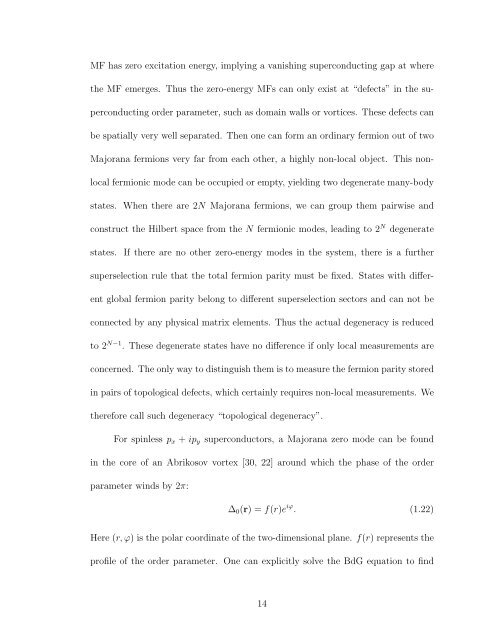ABSTRACT - DRUM - University of Maryland
ABSTRACT - DRUM - University of Maryland
ABSTRACT - DRUM - University of Maryland
Create successful ePaper yourself
Turn your PDF publications into a flip-book with our unique Google optimized e-Paper software.
MF has zero excitation energy, implying a vanishing superconducting gap at where<br />
the MF emerges. Thus the zero-energy MFs can only exist at “defects” in the superconducting<br />
order parameter, such as domain walls or vortices. These defects can<br />
be spatially very well separated. Then one can form an ordinary fermion out <strong>of</strong> two<br />
Majorana fermions very far from each other, a highly non-local object. This nonlocal<br />
fermionic mode can be occupied or empty, yielding two degenerate many-body<br />
states. When there are 2N Majorana fermions, we can group them pairwise and<br />
construct the Hilbert space from the N fermionic modes, leading to 2 N degenerate<br />
states. If there are no other zero-energy modes in the system, there is a further<br />
superselection rule that the total fermion parity must be fixed. States with different<br />
global fermion parity belong to different superselection sectors and can not be<br />
connected by any physical matrix elements. Thus the actual degeneracy is reduced<br />
to 2 N−1 . These degenerate states have no difference if only local measurements are<br />
concerned. The only way to distinguish them is to measure the fermion parity stored<br />
in pairs <strong>of</strong> topological defects, which certainly requires non-local measurements. We<br />
therefore call such degeneracy “topological degeneracy”.<br />
For spinless p x + ip y superconductors, a Majorana zero mode can be found<br />
in the core <strong>of</strong> an Abrikosov vortex [30, 22] around which the phase <strong>of</strong> the order<br />
parameter winds by 2π:<br />
∆ 0 (r) = f(r)e iϕ . (1.22)<br />
Here (r, ϕ) is the polar coordinate <strong>of</strong> the two-dimensional plane. f(r) represents the<br />
pr<strong>of</strong>ile <strong>of</strong> the order parameter. One can explicitly solve the BdG equation to find<br />
14
















